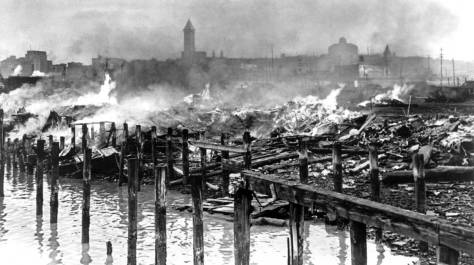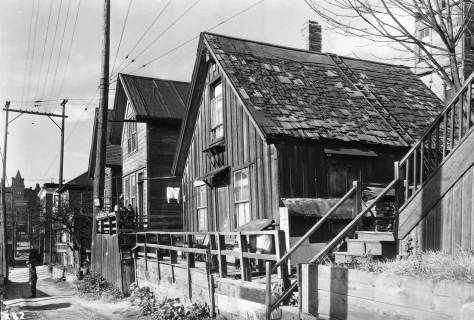(click to enlarge photos)


Mid-march of 2014 – not long ago by book publishing standards – Randal Gravelle began working on his depression-era history, Hooverville and the Unemployed. Gravelle, who has been teaching history in the Everett School District since 1989, explains, “I wanted to read something about Hooverville that was greater than the standard text book story. I made my search, but soon determined that no one had ever written a book on what I consider a natural subject. Honestly, I was floored and told my wife so. She answered, ‘Then write it yourself.’ When my brother gave me the same response, and on the same day, I started in.” The result is a new addition to our Seattle Canon of essential histories.
Eighty years earlier, in 1934, Donald Francis Roy, a UW student in sociology, bought a shack in Hooverville for fifteen dollars and proceeded to research and write his now classic study, “Hooverville: A Study of a Community of Homeless Men in Seattle.” The town’s namesake was, of course, Herbert Hoover, the U.S. president in office during the market crash of 1929. By mapping, numbering and marking (with white paint) the roughly 500 shanties in what he described as “this unblueprinted, tincanesque, architecturaloid” community, Roy, the “college boy,” got close to the residents while



giving them addresses. For his research, Roy did approximately 650 interviews. Six years later, the 1940 Federal Census used Roy’s addresses for gathering its statistics on Hooverville residents. Gravelle, of course, put both Roy’s thesis and the census to good use in his history. Later in 1940 the residents – still almost all of them middle-aged men – were evicted from Hooverville, The former WWI ship-building site was burned to the ground and revived for arming America through another big war.
ABOVE & BELOW: The exodus – for those with “belongings” to salvage – before the conflagration.

The featured ‘then’ picture at the top of Hooverites picking through tideflats garbage appears at the bottom of page 88 in Gravelle’s scholarly and yet lively 285-page history. The last 55 pages are devoted to notes and bibliography, and the greatest contributors to the latter is this newspaper and the Seattle Public Library Foundation that purchased The Seattle Times Archive for Gravelle’s and our use. With his Seattle Public Library card, the author gained access to the key word searchable archives. He notes, “If it were not for The Times it would have been a dead book.” While we sincerely doubt that, we will also join in Gravelle’s generous thanks to this newspaper.



Asked “What are the pickers looking for in the ‘then?’ Gravelle answered “Almost anything that could be recycled or consumed. For instance, at the time, one-hundred pounds of cardboard returned twenty cents and paper twice that.” After photographing Randal Gravelle (left) with their host Joshua Clark, Operations Superintendent for the Light Rail Division of Sound Transit, for his “repeat,” Jean Sherrard cannily took the author to one side for a brief interview. You can see it on video near the top of our blog at pauldorpat.com.
WEB EXTRAS
Anything to add, fellahs? Surely Jean, and more of the similar by places or subjects.
======
OF RECENT INTEREST – While gathering the week’s blog I noticed a generically familiar structure – an electric power transfer station – in the scene from one of our tideland Hooverville suburbs. I also notice a street sign for 6th Avenue nailed to the power pole that rises from the bottom-right of this municipal archive subject. I cannot make-out the other street sign, but imagine given the 1930s dates that this fairly vacant scene would be somewhere south the Sears Building and before Spokane Street was given its new make-over. Next I searched the 1936 aerial survey and low I did find the electric plant. The chosen detail from the ’36 aerial is printed with a detail of the scene printed directly below, but below it. It is clearly the same structure, and sits there near what is now the east side of the East Waterway and just south of Spokane Street, which does not show in the aerial, although the waterway does. It is that gray swath that runs through scene top-to-bottom. I not gone any farther on this, but with the help of more aerials and maps it should be possible to pin-point the location of this little suburb for a person like you who enjoys doing that sort of thing .
========
RARE WOMEN – Not many women lived in Hooverville, which was a community of mostly middle-age, out-of-work Euro-American males. But here are two feminine exceptions. Actually just one. The woman doing the ironing is at work in a make-shift Hooverville hut. The woman at the window – she has been clipped and posed there in a collage constructed by a Post-Intelligencer photographer and retouch artist – is looking down from her home on Beacon Hill and expressing her fear of having such neighbors so nearby. See, she is pointing at them. Perhaps if she could have met the ironing woman – they both wear flower print dresses – she would have been somewhat tranquilized.
SOMETHING ELSE JUST NOTICED – The Hooverville suburb that the home-keeper on Beacon Hill is complaining about is the same grouping of sheds and shacks that are featured with the pond story that appeared in Pacific not so long ago. It is the next-to-last of the thirteen features put of by Ron Edge a few pictures above this one. It is also the same collection of sheds that appears in the sting of primarily feature texts that spill out of – or down from – the featured photo. It is the past feature that is simply titled HOOVERVILLE, but with very large type. That feature show a “now” with some municipal bu ses parked nearby. But now it late and time to retire. Tomorrow we will make a final addition.




















